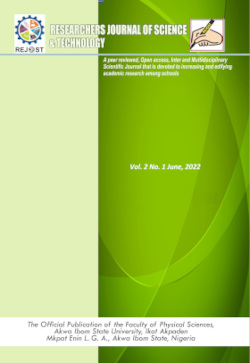Variations in growth and development indices of Abelmoschus esculentus L. Moench cultivated in wet and normal soils in Opolo, Bayelsa State, Nigeria
Keywords:
growth, development, Abelmoschus esculentus L., Moench; wet and normal soils, Bayelsa StateAbstract
Variations in growth and development indices of Abelmoschus esculentus L. Moench were evaluated in the field using wet and normal soils in Opolo, Bayelsa State, Nigeria. Terrestrial plants growing in soil partially or totally submerged due to environmental hazards exhibit deterioration in certain growth and physiological attributes. The study area is a region characterized by seasonal flooding. This study was conducted to examine the response of the test crop growth and development parameters to extreme moisture stress in the soil as well as the effects of such condition on the chemical properties of experimental soil. Soil samples obtained from the two experimental locations at the depth of 1-20cm were analyzed for physico-chemical characteristics using standard procedures. Viable seeds of the test crop were sown in the two experimental soils in rows and the experimental set up was maintained for 8 weeks for determination of growth and development parameters. The results of this study revealed that the pH values of both soils were slightly acidic, however, the pH value of the wet soil was significantly (P < 0.05) lower than that of the normal soil. The contents of available phosphorus, total nitrogen, calcium, sodium and copper in normal soil were significantly (P < 0.05) higher than that of the wet soil, while the magnesium, potassium and iron contents in wet soil were higher than that of the normal soil. The shoot length, leaf number, root length, root number and chlorophyll contents of the test crop in normal soil were significantly (P < 0.05) higher than that of the wet soil. This study suggests that the growth and development of A. esculentus L. Moench could be negatively affected at extreme level of moisture; therefore, appropriate moisture conditions are required for optimum growth performance of the test crop.
References
Agbede, O.O., 2009. Understanding soil and plant nutrition. Nigeria Salmon Press and Co. Nigeria Ltd, 20 – 60.
A.O.A.C., 2003. Association of Official Analytical Chemist. Methods of analysis, Washington DC., U.S.A.
Boll, T., Svenning, J.C., Vormisto, J., Normand, J., Grandez, C., Balslev. H., 2005. Spatial distribution and environmental prefer-ences of the piassaba palm Aphandra Natalia (Arecaceae) along the Pastaza and Urituyacu rivers in Peru”. Forest Ecology and management, pp. 175-183.
Braidy, C., Weil, I., 1999.Soil organic matter, the nature and properties of soil. 12th Edition, Prentice Hall, New Jersey.
Clark, J., 2020. Managing soil and soil fertility after flooding. South Dakota State University Extension.
Dhankhar, B. S., Singh, R., 2009. Okra Hand-book: Global production, processing, and crop improvement. HNB Publishing.
Ekanayake, I. J., Adeleke, M.T.V., 1996.Selected procedures for instrumentation in ecophysiological studies of root crops, procedures manual no.3 (IITA Ibadan, Nigeria: Crop Improvement Division (CID).
Etukudo, M. M., Hamilton-Amachree, A., Roberts, E.M.I. 2015. Eco-physiological studies of elemental and proximate contents of Gnetum-africanumWelw and Telfairia occident-talis Hook seeds from two ecological zones of Akwa Ibom State”. European International Journal of Science and Technology, 4(6), 47-53.
Etukudo, M. M., Onu, B., 2021. Developmental and morphological indices of Phaseolus vulgaris L.and soil physico-chemical properties during serial flooding in Bayelsa State, Nigeria. Nigerian Journal of Pharmaceutical and Applied Science Research (NIJOPHASR), 10(1), 55-60.
Gutierrez- Boem, F. H., Lavado, R. S., Pprcelli, C., 1996. Note on the effects of winter and spring waterlogging on growth, chemical composition and yield of rapeseed”. Field Crops Research, 47, 175–179.
Huang, S., Greenway, H., Colmer, T. D., 2003. Responses of coleoptiles of intact rice seedlings to anoxia: K+ net uptake from the external solution and translocation from the caryopses. Annals of Botany, 91, 271–278.
Jackson, M. B., 2004. The impact of flooding stress on plants and crops. http://www.plantstress.com/Articles/waterlogging_i/waterlog_i.htm.
Jackson, M. B., Colmer, T. D., 2005. Response and Adaptation by Plants to Flooding Stress. Annals of Botany, 96(4), 501–505.
Juo, A. S. R., 1979. Selected methods for soil and plant analysis. International Institute of Tropical Agriculture (IITA), Ibadan, Nigeria.
Kumar, S., Dagnoko, S., Haougui, A., Ratnadass, A., Pasternak, D., Kouame, C., 2010. Okra (Abelmoschusspp.) in West and Central Africa: Potential and progress on its improvement”. African Journal of Agricultural Research. 5(25), 3590-3598.
Lahai, M. T., Ekanayake, I. J., George, J. B., 2003. Leaf chlorophyll content and tuberous root yield of cassava in inland valley.African Crop Science Journal, 2(11), 107-117.
Maynard, D. N., Hochmuth. G. J., 2007. Knott's Handbook for Vegetable Growers. 5th ed. Hoboken, New Jersey: John Wiley & Sons, Inc.
Niger Delta Source: Bayelsa State. (2014). http://nigeriadeltasource.com/bayelsa
Obi, 1. U., 2002. Statistical methods of detecting differences between treatment means and research methodology issues in laboratory and field experiments.Nigeria, AP Express Publishers Limited.
Osim, S. E., Etukudo, M. M., Eze, U. P., Okoye, S. U., Ekwueme.D.C., 2020.Assessment of tolerance of Zea mays L. and physico-chemical properties of soil at flood affected site in BayelsaState,Nigeria. International Journal of Scientific and Research Publications, 10(10), 397-400.
Osuagwu, A. N., Ekpo, I. A., Okpako, E.C., Out, P., Ottoho, P. 2013. The Biology, Utiliza-tion and Phytochemical composition of the fruits and leaves of Gongronema latifolium Benth. Agrotechnol. 2, 115.
Parent, C. C., Nicolas,A., Berger, M., Crevecoeur, M. F., 2008. An overview of plant response to soil waterlogging. Plant stress.Global Science Books. 2(1), 20-27.
Peterson, L. 2002. Analytical method of soil, water, plant material fertilizers (eds.). Soil resources management and analytical services. Soil Resources Development Institute. Danida. pp. 5-16.
Ransom, J., 2013. Impacts of flooding/ water-logging on crop development. USDA National Institute of Food and Agriculture. Extension Agronomist for Cereal Crops.
Rossel, R.A.V., Rizzo,R., Dematte, J. A.M., et al. 2010.Spatial modeling of soil fertility index using visible-near-infrared spectra and terrain attributes. Soil Science American Journal, 74, 1293- 12300.
Udoh, D. J., Ndon, B. A., Asuquo,P. E., Ndaeyo N. U., 2005.Crop production techniques for tropics.Nigeria: Concept Publication Ltd.
Vartapetian, B. B., Andreeva, I. N., Generozova, I. P., Polyakova,L.I., Maslova, I. P., Dolgikh, Y. I., Stepanova, A.Y.U. 2003. Functional electron microscopy in studies of plant response and adaptation to anaerobic stress. Annals of Botany, 91, 155–172.
Visser, E. J. W., Voesenek, A. C. J., Vartapetian, B.B., Jackson, M.B., 2003. Flooding and Plant Growth. Annal. Bot. 91(2), 107–109.
Wang, S.Y., Yu, T., Wang, J. L., Yang, L., Yang, K., Lu, P., 2008. Preliminary Study on Spatial Variability and Distribution of Soil Available Microelements in Pinggu County, Beijing, China. Agricultural Sciences in China; 7(10), 1235-1244.
Downloads
Published
How to Cite
Issue
Section
Categories
License

This work is licensed under a Creative Commons Attribution-NonCommercial-NoDerivatives 4.0 International License.




